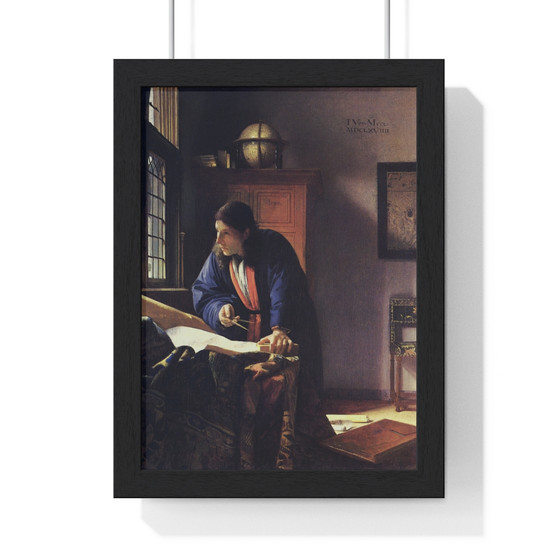Vermeer’s The Geographer
BlogAdmin on 27th May 2022
The Geographer (1668-1669) is painted by the Dutch artist Johannes Vermeer.
Style and variations
The painting depicts a man bent over his working table in his study. He is surrounded by different sources of knowledge about science and trade. The creation of the painting was the result of the Geographer’s awareness about the influx of knowledge, goods, and services from sources around the world. The painting is supposed to have a close resemblance to Vermeer’s artwork called The Astronomer. In both paintings, Vermeer uses the same model in the same attire. Hence, The Astronomer has been considered a pendant painting to The Geographer. However, the measurements of these two paintings are not identical. This is one of the only three paintings which Vermeer had signed and dated, the other two being The Astronomer and The Procuress. They all appear to be variations of a similar idea on three different canvases.
The earliest record of the painting available is only from 1713. Until the late 18th century, The Geographer and The Astronomers were referred to as “Astrologers”. During the period from 1713 to 1877, it changed hands several times until 1866 when it was finally exhibited at the Palais des Champs-Elysees, Paris.
Analysis of the artwork
Geographer
The human figure depicted in the painting as The Geographer is dressed in Japanese-style robes. The figure’s stance stooping over the study table with other cartographic tools like maps, charts, books around him, and a globe and dividers in his right-hand shows his total involvement in the studies. The study has revealed that Vermeer had made several changes in the painting to ‘enhance the feeling of energy in the picture’. The man’s head in the picture was originally turned left of where it is presently shown. Vermeer‘s use of light and these tools give an air of revelation to the painting, a perspective that perhaps catapulted the painting to phenomenal fame.
According to an art critic, details of the man’s face are slightly blurred, suggesting its movement. The experts are of the opinion that his narrowed eyes might perhaps indicate squinting in the sunlight or an indication of intense thinking. The experts also feel that the pose of the Geographer in the painting matches that of some of the drawings created by Rembrandt and Nicolaes Maes, from whom Vermeer drew inspiration.
Tools
According to art historians, the depiction of common cartographical instruments in the background such as the tools used to measure the angle and movement of celestial bodies may be based on the scientist Anthony van Leeuwenhoek and was not a mere depiction of an average scientist. Anthony van Leeuwenhoek had been trained as a surveyor and had knowledge about the equipment needed to create a map. According to these experts, he and Vermeer were contemporaries and hence the idea of collaboration between the two was possible.
Vermeer has drawn a chart depicting the sea coasts of Europe and it is shown as hanging on the back wall in the painting. The globe sitting on the shelf behind the Geographer character shows the Asian continent, specifically the Bay of Bengal and the Indian subcontinent. The painter had successfully established a connection between these continents through the advances in exploration that were taking place during this period. Vermeer had also hinted at the increase in global trade, especially between Europe and Asia, and the influx of knowledge, goods, and services from places around the globe. This was also that crucial period of time in history when the Dutch East India Company was making great headways in developing trade with the Indian subcontinent.
It is really awe-inspiring to know that a painter who was not known to be an avid traveler could envision such a complex subject as trade between continents that are far apart from one another. This is an indication that Vermeer was painting during the golden era of Dutch painting, depicting advancement in science and trade. Through this marvelous piece of painting, Vermeer not only left an indelible impression on the art viewers but also gave an invaluable insight into the science and innovations of his day.
The Astronomers and The Geographer – Comparisons
They are of similar sizes and were painted at about the same time in the 17th century. They were both signed and dated one of the two years 1668-1669. The Astronomer was painted first. These two pictures were bought and sold together as companion pieces four times during the eighteenth century. They were first recorded in public in 1713.
Both the paintings depict a similarly dressed man deeply engrossed in scientific studies, one relating to celestial studies and the other, terrestrial. In The Astronomer, the painter has drawn a table full of cartographic aids, such as an astrolabe, a pair of dividers, and several books. The astrolabe is an instrument that dates back more than 2000 years. It is used to observe the positions of stars. It is also used for time-keeping navigation and surveying with modifications. The Astronomer has kept one of the books opened in front of him and it appears to have clues to his celestial studies. However, he seems to have focussed his attention on a large celestial globe on the table.








